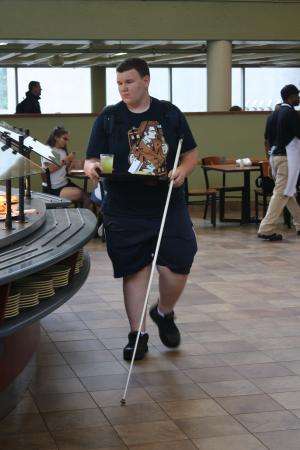Navigating indoors, where GPS is unavailable, is one area where the EMS device could be helpful to blind people. Credit: NFB
Navigation devices used by blind people today lack the ability to operate indoors and other areas where GPS is not available, and are unable to help the user deal with items that aren't part of maps, such as crowds and cars. Auburn University is building a prototype device under contract to the Federal Highway Administration that can address both problems, combining technology that it developed for Department of Transportation with technology that Draper Laboratory developed for soldiers and unmanned vehicles.
Auburn is building the device to track the movements of the wearer while integrating data from GPS satellites, visual information from cameras, and wireless information from pedestrian signals in order to enhance safety and mobility under a contract awarded in April. The Extended Mobility System (EMS) will guide wearers as they travel through unstructured environments where GPS navigation is not sufficient, such as transit stations, areas of construction, and event arenas.
Auburn and Draper are working with the National Federation of the Blind to ensure all of the visually-impaired wearers' needs will be addressed in their design. A prototype is expected to be ready in 2015.
"The National Federation of the Blind is pleased to provide input on this important project, which has the potential to assist the blind with indoor navigation and with travel in other areas where GPS technology is not functional or appropriate," said Dr. Marc Maurer, NFB president. "We look forward to the results of this exciting collaboration."
In addition to the blind, people with other sensory as well as cognitive limitations could also benefit from the EMS device.
Current pedestrian navigation systems often lack detailed enough maps to work in environments such as train stations and parking lots, as well as the constant updates that would be needed for alternative routes if a sidewalk is closed due to construction, for example. Also, many of those devices do not work at all inside office buildings, concert halls, and other areas where the GPS signal does not reach. The system can work independently from GPS signals using built-in cameras, inertial measurement units (IMUs), and concepts from advanced robotics and artificial intelligence to ensure real-time guidance for the wearer.
The researchers describe an example in which a concert-going wearer uses an EMS to successfully navigate through underground subway tunnels using information gathered from its cameras and internal map of the train station – directing them possibly through tactile directional indicators on their belt. The cameras assist them in identifying and following signs pointing to the concert arena, and once there, the EMS will wirelessly access maps from the arena's marketing department to direct her to her ticketed seat.
Current systems also struggle when WiFi signals or pre-mapped landmarks are not available, but the EMS devices uses Draper's visual odometry technology as "eyes" for the wearer, noting and relaying visual, directional, and distance information. Visual odometry interprets video from a pair of cameras to map the objects in a given environment and uses Draper's algorithms and software to address challenges as complex as a crowd of pedestrians moving in a variety of directions. This is accomplished by comparing the Inertial Measurement Unit sensor readings with the camera information and algorithmically deciding which is best, for example ignoring the camera for short periods when the camera may be blocked or confused by moving objects in the scene.
The researchers describe a potential prototype as an ankle bracelet with inertial sensors and a small camera placed in a pair of glasses. While an earpiece was originally considered, NFB members said that using one could obstruct their hearing, which they heavily rely on in the absence of sight, according to David Bevly, a professor in Auburn's Department of Mechanical Engineering, who leads the university's work on the project. Instead, tactile vibrators may provide directional guidance, he said.
Provided by Auburn University























